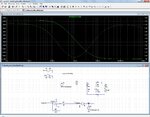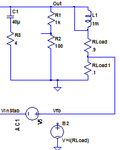DanyR
Member level 3

- Joined
- Aug 23, 2015
- Messages
- 67
- Helped
- 6
- Reputation
- 12
- Reaction score
- 6
- Trophy points
- 8
- Location
- Nieuwpoort, Belgium
- Activity points
- 677
The following circuit (stability measurement) shows a problem: The simulation waits to show curves forever (well, I did not wait that long), and when I interrupt the simulation manually it shows the error "Failed to find the DC operating point for AC analysis".

When I however connect Vfb (feedback voltage) to the connection of R1 and R2 in stead of to the voltage source B2, the simulation works fine, as shown in the curves above. (the curves are from the "simulatable" version of the diagram).
I've tried changing almost all parameters in the LTSpice IV control panel (including checking "NoOpiter"), but nothing helps.
Anyone any idea? Thanks in advance!
The files:
I've also added the log file in case it reveals the reason for the problem.

When I however connect Vfb (feedback voltage) to the connection of R1 and R2 in stead of to the voltage source B2, the simulation works fine, as shown in the curves above. (the curves are from the "simulatable" version of the diagram).
I've tried changing almost all parameters in the LTSpice IV control panel (including checking "NoOpiter"), but nothing helps.
Anyone any idea? Thanks in advance!
The files:
I've also added the log file in case it reveals the reason for the problem.
Attachments
Last edited:

